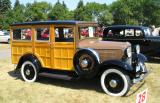|
|||||||
| Sponsored Links (Register now to hide all advertisements) |
|
|
 |

|
Thread Tools | Display Modes |
|
|
#1 |
|
Senior Member
Join Date: May 2010
Location: Taranaki, New Zealand
Posts: 923
|
I am having a problem with the 1932 - B-2503 rear brake rod supports purchased from Ford parts suppliers.
I find the rubber sleeve grips on the brake rod and tears out the inside of the outer circular rubber, therefore they do not last very long. On the 1935 -1936 - 48-2503 rear brake rod supports they have a different system but I do not think they will fit onto the 1932 rear radius rod. |
|
|

|
|
|
#2 |
|
Senior Member
Join Date: May 2010
Location: Masterton, New Zealand
Posts: 3,998
|
Ian, I am not intimate with 32's, so am probably unqualified to respond. However, that support is basically supposed to be an anti-rattler isn't it; as such, could you just open up the inside dia sufficiently to enable the rod to float through it without binding? Brian
|
|
|

|
| Sponsored Links (Register now to hide all advertisements) |
|
|
|
|
#3 |
|
Senior Member
Join Date: May 2010
Location: southeastern Michigan
Posts: 10,601
|
The design of the '32-'34 rear brake support is such that the rubber part in contact with the brake rod is like thin wall tubing and can't be opened up without weakening it further. Applying clear silicone to the brake rods in the area of contact with the support seems to help by reducing the friction between the rod and the rubber.
|
|
|

|
|
|
#4 |
|
Senior Member
Join Date: May 2010
Location: Richmond Heights, 44143
Posts: 579
|
Ian,
I usually cut out that thin rubber and put a nice rubber grommet in place of it. That always worked for me. JimOH |
|
|

|
|
|
#5 |
|
Senior Member
Join Date: May 2010
Posts: 905
|
I have some n.o.s ones and they are soft yet and I know you will not have a problem.
|
|
|

|
|
|
#6 |
|
Senior Member
Join Date: May 2010
Posts: 485
|
Sponsored Links (Register now to hide all advertisements)
As others have said NOS or NORS ones are available for minimal cost and the old rubber will probably be good forever. Can't always say the same for reproduction stuff. Thanks Floyd |
|
|

|
|
|
#7 |
|
Senior Member
Join Date: May 2010
Location: southeastern Michigan
Posts: 10,601
|
Floyd,
Floyd, The rubber surrounding the 'hoop' has a convex side and a concave side. They should be mounted so that the convex side faces forward on the radius rods. The steel portion of the super rare early version of the supports was made entirely out of heavy wire, unlike the later version which was primarily a stamping, and as you point out, has no alignment dimple. I had some early ones made up (the steel portion) and if you wanted that type you could carefully cut off the rubber portion of a couple of reproduction supports and install them on the early wire type (the rubber portion was the same on both versions). If interested, please send me a PM. (The ones that you see in the book that have the convex portion of the rubber facing rearward are the early all-wire type and the chassis they are on is likely a prototype as it has some non-production characteristics.) If you want to use the later type, you will need to drill the alignment holes in your radius rods ahead of the existing holes as they will end up at the wrong angle relative to the brake rod without the hole. I've used NOS ones for years and they do seem to hold up well if the rubber is not petrified. Dave |
|
|

|
|
|
#8 |
|
Senior Member
Join Date: May 2010
Location: Lake City Mi.
Posts: 807
|
On my 34 I had to use silicone spray to get them on, they were so tight I thought they would tear. David G also mentioned silicone.
Gary. |
|
|

|
 |
«
Previous Thread
|
Next Thread
»
|
|
| Sponsored Links (Register now to hide all advertisements) |
|
|
All times are GMT -5. The time now is 08:53 AM.







 Linear Mode
Linear Mode

